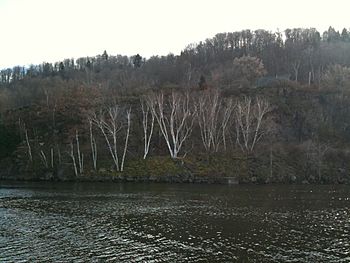Moss Island facts for kids

Moss Island in 2010
|
|
|
Location of Moss Island in New York State
|
|
| Geography | |
|---|---|
| Location | Mohawk River, New York State Barge Canal |
| Coordinates | 43°02′23″N 74°50′53″W / 43.03972°N 74.84806°W |
| Area | 14 acres (5.7 ha) |
| Length | 1,500 ft (460 m) |
| Width | 625 ft (190.5 m) |
| Administration | |
| State | New York |
| County | Herkimer County |
| City | Little Falls, New York |
| Designated: | 1976 |
Moss Island is a cool island in Little Falls, New York. It sits right between the Mohawk River and the New York State Barge Canal. This island is made of a special type of rock called syenite. It became an island when people built canal locks to help boats get around a 40-foot waterfall.
Moss Island is famous for its huge, deep holes in the rock, called potholes or giant's kettles. These can be 40 to 50 feet deep! It's also a very popular spot for local rock climbers. Because of its unique features, Moss Island was named a National Natural Landmark in 1976. Since 2008, people in the area have been working to make Moss Island a New York State Park.
Contents
Exploring Moss Island's Features
Moss Island is about 1,500 feet long and 625 feet wide. That's like five football fields end-to-end! The Mohawk River runs along its north side, and the New York State Barge Canal is on its south side. The island is covered with small oak trees.
If you look closely, you might see glacial striations in some places. These are cool scratch marks left on the rocks by giant glaciers that moved across the land long, long ago. The cliff on the south side of the island is about 45 feet tall at its highest point. A road runs next to this cliff for about three-quarters of the island's length.
The Rocks of Moss Island
The cliffs on Moss Island are made of a rock called metasyenite. This rock is a type of igneous rock, which means it formed from hot, melted rock (magma) that cooled down. It's similar to granite, a rock you might know.
After the syenite rock first formed, it went through a lot of heat and pressure deep underground. This process changed the rock, making it metamorphic. The minerals inside rearranged themselves, but the rock didn't melt again. This is how syenite became metasyenite.
A Look at Moss Island's History
People started building locks around the waterfall here way back in 1793. These locks helped boats travel past the falls. You can still see an old Erie Canal lock from the 1800s near the island's southeastern road.
Today, Lock 17 is next to Moss Island. It's one of the tallest locks of its kind in the world and the biggest in the New York State Barge Canal system. This lock uses a special "guillotine gate" on its eastern side to control the water.
In 1974, there were plans to build a bridge for the New York State Thruway right over Moss Island. But after people spoke out against it, the bridge was planned to go around the island instead.
Fun Things to Do on Moss Island
Moss Island is a great place for outdoor activities. It's especially famous for its rock climbing. The island also has special access for fishermen with disabilities.
You can visit Lock 17 from the island and watch how it works. There's a walkway next to the guillotine gate that lets you cross the canal. The best part is that parking, visiting the lock, and exploring Moss Island are all free! The island is known for its cool circular rock formations, and the cliffs on the opposite side are a popular spot for climbers.
Rock Climbing Adventures
Many climbers call Moss Island an "outdoor gym" because it has so many different climbing routes. There are climbs that are very easy for beginners and some that are super challenging for experienced climbers. It's also very convenient to get to the climbing spots, usually just a 5-minute walk to set up your gear.
The cliffs are clean and safe for climbing, with over 100 established routes. These routes range in difficulty from 5.1 (very easy) to 5.13 (very hard). Many popular routes have bolts already in place for "top rope" climbing, which is a safer way to learn. A classic route in Little Falls is "Goat Crack" (5.2), which is a 45-foot slab. Many traditional climbers do their first "leads" (where they place their own safety gear) on this route. Famous climbers, like Lynn Hill, have even climbed here!
Across from the island, there's another cliff with a visible crack called "Crucifix" (5.8). Further downstream, there's a former cement factory with a 0.25-mile long, 100-foot tall cliff called "the dihedrals." However, this cliff is privately owned and not open to the public.


